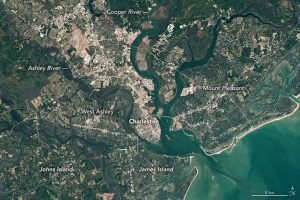
 With its population rising three times faster than the national average, the Charleston metropolitan area is among the fastest-growing places in the United States.
With its population rising three times faster than the national average, the Charleston metropolitan area is among the fastest-growing places in the United States.
Large tracts of coastal forests and farmland have been cleared and developed in recent decades to accommodate new residents to the area. The pair of natural-color Landsat images above”the left image from 1985 and the right from 2020”show some of the changes. Forests and marshes appear green; developed areas are gray. Places where widespread development has occurred include James Island, Johns Island, Daniel Island, West Ashley and Mount Pleasant.
A similar story is playing out in cities all across the United States, but the Charleston area stands out in one critical way”much of the new development has happened on low-lying land especially vulnerable to sea-level rise and flooding. Older, more-established parts of Charleston”often on slightly higher land but surrounded by water on three sides”face similar challenges. As one form of remediation, local and federal government officials are moving forward with plans to build a seawall to protect the city's historic downtown from encroaching water.
Other southeastern coastal cities face similar problems but with one caveat: the lowcountry of South Carolina is low, said Norman Levine, director of the Santee Cooper GIS Laboratory and Lowcountry Hazards Center at the College of Charleston. Over one-third of all homes are built on land that sits below 10 feet (3 meters) of elevation.
However, hurricane storm surges up to 9 feet have been measured in the past, and climatologists expect surges to grow larger as global climate warms and storms become more intense.
Image Credit: NASA Earth Observatory image by Lauren Dauphin, using Landsat data from the U.S. Geological Survey.

